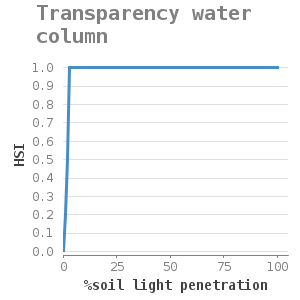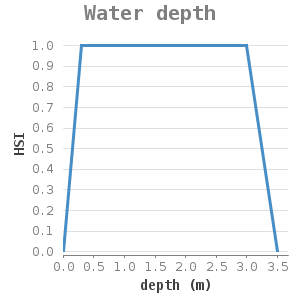H3140 - Hard oligo-mesotrophic waters with benthic vegetation of Chara spp h1. General
General characteristics |
|
|---|---|
Common name |
Hard oligo-mesotrophic waters with benthic vegetation of Chara spp |
Region |
The Netherlands |
Water systems |
Lakes and marshes |
Nature parameter |
habitats |
HR nr |
H3140 |
Fact sheet by |
H. Coops |
|
Picture: J. van Schie |
Description habitat
General occurrence
This habitat type is widespread in Europe. Plant communities of this habitat type occurring in The Netherlands are for the main part restricted to the north-western European lowland. Charales are pioneers in oligotrophic, clear waters. Under these circumstances, they develop into thick carpets composed of several Charales species. Other water plants can hardly penetrate these carpets. This habitat type can be found in Europe in many large lakes and pools with stonewort. The species variety is high in The Netherlands, of the 40 species in Europe, 20 occur in The Netherland. Consequently, The Netherlands is very important for the development of this habitat type.
The plant communities belong to the association Charion fragilis (4Ba). Characteristic species for calcareous waters are Common stonewort (Chara vulgaris), Rough stonewort (Chara aspera), Bristly stonewort (Chara hispida), Opposite stonewort (Chara contraria) and Starry stonewort (Nitellopsis obtusa). In slightly brackish waters, also Convergent stonewort (Chara connivens) and Bearded stonewort (Chara canescens) can be found.
Characea occurs in shallow parts of the large lakes of the IJsselmeer area (0.5-2.5m), provided that water quality has sufficiently improved and enough light penetrates to the soil. Extensive fields of stonewort can be found in the Veluwe border lakes. Over the past years, this species is also occurring more frequently in the Gooimeer, Zwarte Meer and along the Frisian coast.
Environmental conditions
Characea sp develop in shallow waters with a varied chemical composition (#3). The maximum depth at which Characea can grow due to light restriction, is determined by the water column transparency. Turbulence in the water column and grazing hinders the growth of stonewort in very shallow waters (lakes with a fixed water level of < 20cm). Alkalinity can be very high. In brackish lakes and pools, stonewort can be a determining factor. It needs basic conditions (pH>6) and it can grow on various soil types (sand, clay and loam).
Extended research of the IJselmeer area showed that the occurrence of Chara sp is mostly related to transparency and depth, especially by pinpointing the areas where Chara does not occur. To properly predict locations where Chara occurs, its occurrence and absence of the year before must be added (#1).
Control and growth opportunities
Chara are sensitive to elevated turbidly caused by nutrient supply, resuspension, etc. Other water plants or algae will then rapidly displace it. As Chara is capable of enhancing transparency, they can survive even at lower visibility. Recolonisation of vegetation is only possible in very transparent circumstances. The control of Chara should be aimed preliminary at preventing high nutrient loads and other turbidity sources. In addition, maintaining shallow waters is a prerequisite.
The growth of Chara can be enhanced through measures aiming to enhance transparency, such as active biological control or flushing. Measures, such as selective mowing of water plants that grow higher then Chara and putting out spore plants have produced varying results.
Dose-effect relations
Flow chart
Dose-effect relations

%light to the soil |
HSI |
|---|---|
0 |
0 |
1 |
0.2 |
2 |
0.5 |
3 |
1.0 |
100 |
1 |
Transparency water column: here, a relative measure indicates the water transparency (transparency/depth), in which it is assumed that positive photosynthesis of water plants is not possible if transparency (Secchi) is roughly half the water depth, corresponding with a 3% light reduction to the soil.
Soil light penetration is essential to Charales because of their low growth.

depth (m) |
HSI |
|---|---|
0 |
0 |
0.3 |
1 |
3.0 |
1 |
3.5 |
0 |
> 3.5 |
0 |
Water depth: this relation is based on the deduction of the reference depth limit for aquatic plants to determine the “growable zone” (ref 2). The described maximum depth (in the figure indicated at 3m) is water type specific.
Please note that the model MACROMIJ uses a logistic response model. For more information on that topic, you can refer to the dose effect relation of Chara spp.
Uncertainty and validation
The above mentioned dose effect relation for transparency/depth is a very rough calculation of the potential area suitable for the growth of aquatic plants in lakes. For applications that are more specific it is advised to use the water plants model MACROMIJ. MACROMIJ has been developed based on data of the IJsselmeer area, but can also be applied to other large lakes.
These dose effect relations have been tested according to measurement data of the Markermeer. There is a 77% chance that the dose effect relations for the habitat type Hard oligo-mesotrophic waters with benthic vegetation of Chara spp h1 (H3140) predict the occurrence correctly, there is a 76% chance on a correct prediction of absence and accuracy is 81% (link to report to be added soon).
Applicability
These dose effect relations apply to large, shallow lowland lakes. MACROMIJ relations have been derived based on an extensive data set of the IJsselmeer area (#1, #2).
Example project
References
1 Van den Berg, M.S., M. Scheffer, E. van Nes & H. Coops (1999) Dynamics and stability of Chara sp. and Potamogeton pectinatus in a shallow lake changing in eutrophication level. Hydrobiologia 408/409: 335-342.
2 Van den Berg M.S., W. Joosse & H. Coops (2003) A statistical model predicting the occurrence and dynamics of submerged macrophytes in shallow lakes in the Netherlands. Hydrobiologia 506-509: 611-623. Download artikel
3 E. Nat et al. (1994) Historisch en actueel verspreidingsbeeld van kranswieren in Nederland in samenhang met waterkwaliteitsfactoren.
